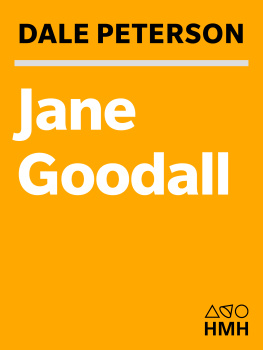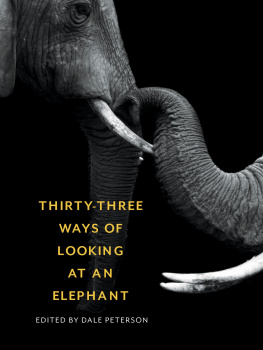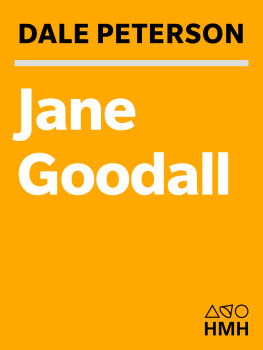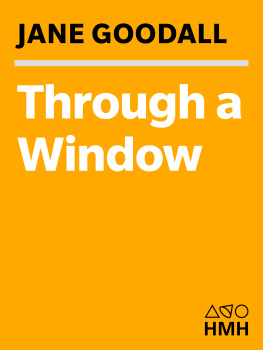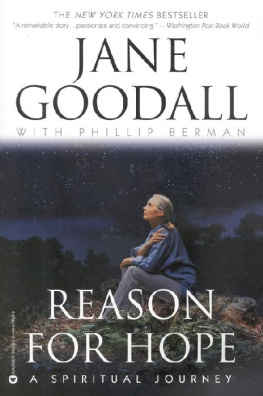Copyright 2006 by Dale Peterson
ALL RIGHTS RESERVED
For information about permission to reproduce selections from this book, write to Permissions, Houghton Mifflin Harcourt Publishing Company, 215 Park Avenue South, New York, New York 10003.
www.hmhco.com
For more information about Jane Goodall and her continuing initiatives in wildlife research, education, and conservation, contact the Jane Goodall Institute at www.janegoodall.com.
The Library of Congress has cataloged the print edition as follows:
Peterson, Dale.
Jane Goodall : the woman who redefined man / Dale Peterson.
p. cm.
Includes bibliographical references and index.
ISBN -13: 978-0-395-85405-1
ISBN -10: 0-395-85405-9
1. Goodall, Jane, date. 2. PrimatologistsEnglandBiography. 3. ChimpanzeesTanzaniaGombe Stream National Park. I. Title.
QL 31. G 58 P 47 2006
590.92dc22 2006006050
e ISBN 978-0-547-52579-2
v2.1014
For Wyn Kelley,
for the chimpanzees,
and in memory of Robbie and Kris
Prologue
SHE STEPS INTO a halo of light, places a toy stuffed monkey next to a small sheet of notes and a glass of water at the podium. Her face becomes a series of curvesarched eyebrows, finely defined cheeksand a wave in the hair (thick, an edge of pure white turning into gray and then brown, with lurking strands of honey blond) rolls to the ponytail in back. She wears a simple blue dress with white buttons. Black turtleneck beneath. No makeup other than a little lipstick. And she opens with a greeting from the chimpanzees: noisy inhalations and hooting exhalations building in volume and climaxing into screams.
She speaks, and her hands, fingers spread, move like flags, like signals or semaphores. She has a soft, almost musical voice modulated by an educated accent and polished enunciation. She creates a sense of deep relaxation, a natural, almost hypnotic connection with her audience.
She describes her early love for animals, speaks of taking earthworms to bed and sneaking into the henhouse. She recollects her mothers encouragement. She tells of her childhood reading: the journey Doctor Dolittle took to Africa, for instance, to release circus animals. She loved that bridge the monkeys made with their hands. But then she met Tarzan! And in that childhood and those childish mental images she learned what her future would be. I vowed that I would go to Africa, she says, live among the animals, and write books about them. She remembers meeting the great Louis Leakey, then going to find the chimpanzees in their forest. She recalls their names and personal stories. She refers to the hostility she first experienced at Cambridge University, where she was informed that chimpanzees do not have personalities, minds, or emotions. They should be given numbers, not names....
She is a gifted storyteller, and she organizes her lectures around anecdotes, images, and symbols that unfold, one after the other, perfectly. She rarely refers to her notes, animating her talk with gestures and spontaneous sound effects. Let me tell you a story, she says, because sometimes stories are the best way to understand things. And she sees the story while telling it: drawing characters with her hands, imitating actions, illustrating thoughts. She speaks of herself at a critical moment, looking upand looks up. She describes charging angry male chimpanzees with arms bulked out, hair standing on endand shakes her body in excited ferocity. She speaks of a chimp grinning in fearand makes the grin. Imagine were in a forest, and there are vines hanging down, she saysand she raises a hand and begins tracing vines in the air.
She is a small woman of obvious energy and courage. Against a dark and shadowy background, her face is bathed in light, her hair silvered by the light, and her voice echoes throughout the hall to an audience of several hundred or a few thousand.
The talk ends with an appeal. Perhaps it is the story about a zoo visitor who courageously jumped into a moat to save a drowning chimp named Jojo and then later recalled, I looked into his eyes, and it was like looking into the eyes of a man, and the expression seemed to say, Wont someone help me? And she asks her audience rhetorically, Why am I traveling the world on this crazy schedule, traveling more than three hundred days in the last year? It is because I too have looked into the eyes of chimpanzees at the edge of existence, and felt those eyes say, Wont someone help?
She is a celebrity, a hero, an icon, and her lectures can be evangelistic experiences characterized by rapt attention, spontaneous tears, standing ovationsthe workswith, at the end, an enthusiastic mobbing. After the lecture, members of the fundraising institute funnel the excited audience toward the membership and memento sales and the vast stacks of bookscopies of almost everything she has ever written. People buy, and then they expect an autograph and, if possible, an exchange of words. As the long line of supplicants creeps forward, her personal assistant organizes: answers questions and, holding open a book to the right page, leans down to communicate special requests. The assistant, standing, gives the impression of being always cheerful. The woman, seated, seems ever patient. She signs and smiles and chats and signs again for as long as it takesan hour, two, or three.
People approach, lean in closely, act as if they already know her. And she, always perfectly at ease, serene, listens quietly, responds appropriately. I was on a flight to Arusha, someone says, and you were there in business class. I talked to you. It was March 2. Oh, yes, she says, not mentioning the fact that she has flown three or four dozen times since then.
A round-faced young woman with an upturned nose and an open smile says, Ive been working with endangered species. The woman nods affirmatively, with interest.
An older man approaches: Sometime, if you have a moment after all this, I would like to tell you two stories about my own experiences with chimpanzees. I think you will be interested.
A pair of teenage girls: Were doing a collection of womens first period stories, and wed be honored if you would contribute.
Someone else (in tears): Youre my hero. You inspired me to join the Peace Corps.
And: May the universe bless your work.
Thank you, someone else says, pulling up a freshly autographed book. This is one of the most memorable moments of my life.
The line feels endless. The woman listens patiently to everyone.
A young girl with braces on her teeth: When I was in sixth grade, I had to do a research project. I did it on chimpanzees. And you!
Another (in tears): Thank you for everything. Im just one of your greatest fans.
And: I just wanted to say, I dressed up as you for Halloween.
The wise woman of silvered hair and serene mien smiles, responds, and handles the books. She writes: Follow your dreams and Remember what my mum saidNever give up! And then, in a neat, plain script, she signs her name: Jane Goodall.
PART I
THE NATURALIST
Daddys Machine, Nannys Garden
19301939
MORTIMER HERBERT MORRIS-GOODALL was a member of the prosperous middle class, a status his family had acquired during the previous century as a result of initiative, industry, luck, and playing cards.
According to family tradition, some ancient Goodall experienced a more than passing association with the gallows, as either a hangman or hanged man; but the familys more reliable record starts with the birth of Charles Goodall, on December 4, 1785, in the town of Northampton. By the early 1820s, Charles had finished his printers apprenticeship in London and struck out on his own as a small-scale manufacturer of playing cards and message cards. Business was good, and he moved into progressively larger premises until he built a factory at 24 Great College Street. By this time the concern was known as Charles Goodall & Son.
Next page
